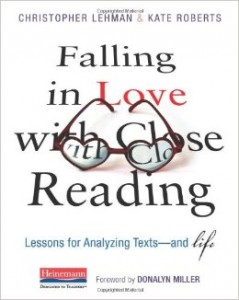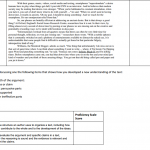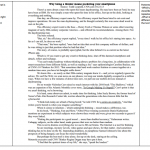 We’re about four weeks into a new school year, and although I ended the summer refreshed and excited for the coming year, I also feel like I never left. I spent this summer immersed in professional learning that came in many forms: presenting at conferences, attending workshops, and reading–nine books total, eight of them professional. One of the books I read (on an airplane, en route to Florida) was Kate Roberts’ and Chris Lehman’s Falling in Love with Close Reading. It was a fantastic, quick read and was filled with practical ideas to take back to my own classroom.
We’re about four weeks into a new school year, and although I ended the summer refreshed and excited for the coming year, I also feel like I never left. I spent this summer immersed in professional learning that came in many forms: presenting at conferences, attending workshops, and reading–nine books total, eight of them professional. One of the books I read (on an airplane, en route to Florida) was Kate Roberts’ and Chris Lehman’s Falling in Love with Close Reading. It was a fantastic, quick read and was filled with practical ideas to take back to my own classroom.
The authors shared a routine where kids first read with a specific lens in mind, annotating as they go. After reading and annotating, students then look for patterns in what they noticed with that particular lens. After looking for patterns in their thinking, students write to develop and solidify a new understanding about the text. I loved this idea of having a routine for reading and annotating that can be adapted for both fiction and nonfiction texts, and I knew I wanted to include this routine in my instruction.
In June, I presented at the MiELA Summer Institute and probably learned just as much as the participants in the room. One of my takeaways was a way to infuse more nonfiction into my classroom through short weekly nonfiction articles, much like Kelly Gallagher’s Article of the Week. When teacher participants talked about how they used the article of the week in their classrooms, I knew I wanted to try using this idea as well.
As the school year approached, I began thinking about how I might merge these two ideas into something that would work for me as a teacher and for my classroom. Last year, I tried out a strategy that ended up having multiple names: Text in the Middle, Two Draft Read, Three Draft Read, etc. The concept is the same, though. Whatever text you want to use is in the middle of the page and to the right and left are spaces for specific annotating or thinking tasks. I decided that this would be a great tool to combine the ideas from Falling in Love with Close Reading and Article of the Week.
I chose one of the articles from Gallagher’s archive, “Why Being a Thinker Means Pocketing Your Smartphone/Have Smartphones Killed Boredom (and Is That Good)?” and formatted it to fit into the Text in the Middle template I had created. (image to the left) I then thought about the lens through which I wanted students to read. Since this was a nonfiction piece that had a clear claim and because I wanted to get students thinking about claims and evidence from the get go, I decided to have students look for the author’s claim, reasons the author’s claim was true, evidence to support the claim and reasons, and a counterargument, if present. I first modeled for them what it would look like for them to read and annotate in this way, then students had the choice to continue reading and annotating either independently or in a partnership.
I’d planned for students to get to the second part of the task the same day, but things usually take longer than I think they will, so the next day, students looked for patterns in what they had annotated the day before. Specifically, they were looking for ideas that were repeated or ideas that stood out as particularly interesting. They made annotations to show these patterns in the right hand column.

Click to read.
The last step in this process is for students to write a response to the text that shows how they developed a new understanding of it (see image to the right). In this case, they were writing about the validity and strength of the argument and chose a specific piece of the argument on which to focus, like the claim or the author’s use of evidence.
This routine took a bit of front loading, but I can see how once students get used to it, the process will become automatic, which will hopefully make analyzing texts a more familiar process for my students as well.
Bibliography
“Article of the Week.” Kelly Gallagher. N.p., n.d. Web. 25 Sept. 2014.
Lehman, Christopher, and Kate Roberts. Falling in Love with Close Reading: Lessons for Analyzing Texts and Life. New York: Heinemann, 2013.
 Jianna Taylor is an ELA and Title 1 teacher at Orchard Lake Middle School in West Bloomfield. She is a member of the AVID Site Team and Continuous School Improvement Team at her school, among other things. She is also a MiELA Network Summer Institute facilitator and member of the OWP Core Leadership Team. Jianna earned her bachelor’s degree from Oakland University and her master’s degree from the University of Michigan.
Jianna Taylor is an ELA and Title 1 teacher at Orchard Lake Middle School in West Bloomfield. She is a member of the AVID Site Team and Continuous School Improvement Team at her school, among other things. She is also a MiELA Network Summer Institute facilitator and member of the OWP Core Leadership Team. Jianna earned her bachelor’s degree from Oakland University and her master’s degree from the University of Michigan.


 Different disciplines define “audience” using other words, but it all comes down to the perception and experience of the end user. All products, all successful products, are designed with the user in mind, as determined by product testing or a focus group. Art and music, while often very personal, succeed when they “find and audience.” Sketching, journaling, and playing random chords because they please you is fine because you are the only audience. But if you want to find out if you’re good, however that’s defined, you need an audience.
Different disciplines define “audience” using other words, but it all comes down to the perception and experience of the end user. All products, all successful products, are designed with the user in mind, as determined by product testing or a focus group. Art and music, while often very personal, succeed when they “find and audience.” Sketching, journaling, and playing random chords because they please you is fine because you are the only audience. But if you want to find out if you’re good, however that’s defined, you need an audience. In the past couple of years, I have been putting more and more emphasis on the importance of audience in writing. I talk with my students about who their audience is, its characteristics, what moves it, and recently, we talked about what might delight the audience. The mantra “when you write for everyone, you write for no one” echoes through my room as we try to imagine that one person we’re trying to reach. (I know who it is for this piece.)
In the past couple of years, I have been putting more and more emphasis on the importance of audience in writing. I talk with my students about who their audience is, its characteristics, what moves it, and recently, we talked about what might delight the audience. The mantra “when you write for everyone, you write for no one” echoes through my room as we try to imagine that one person we’re trying to reach. (I know who it is for this piece.) Rick Kreinbring teaches English at Avondale High School in Auburn Hills, Michigan. His current assignments include teaching AP Language and Composition and AP Literature and Composition. He is a member of a
Rick Kreinbring teaches English at Avondale High School in Auburn Hills, Michigan. His current assignments include teaching AP Language and Composition and AP Literature and Composition. He is a member of a